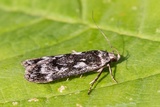Anacampsis blattariella (Hübner, 1796) Species
Last modified: Jan. 25, 2025, 11:11 a.m.
A rather common species in Belgium, more observed in the northern part.
Details
- Classification
- Family: Gelechiidae > Subfamily: Anacampsinae > Tribus: Anacampsini > Genus: Anacampsis > Species: Anacampsis blattariella
- Vernacular names
- Spikkelpalpmot (NL), Birch Roller, Birch Sober (EN), Birken-Palpenmotte (DE)
- Synonyms
- Anacampsis betulinella Vári, 1941
- First mention in Belgium
- Janmoulle E. 1948a. Espèces nouvelles pour la faune belge. — Lambillionea 48: 20–21, 33–34, 50, 82–83. On page 20.
- Status
-
Native
Distribution
Imago
Wingspan 16–19 mm. The moth is a larger Gelechiid species that holds its wings flat at rest and it
has a black and white, rather sooty appearance with a transverse pale fascia at three-quarters (if visible) and often has a strong zig-zag style in the costal half.
The moths of these two species (A. blattariella and Anacampsis populella) are so variable that it is not possible to determine each moth with certainty based on its external appearance.
Species can only be determined through genital examination or breeding!
Genitalia
Male: The gnathos of A.blattariella is noticeably less robust than that of Anacampsis populella, the uncus has broadly rounded lateral lobes with a studded central section produced a little posteriorly, but orientated more in the transverse than longitudinal axis and the valvae appear longer than those of Anacampsis populella.
Female: The crucial feature is in the shape of the posterior margin of the dorsal plate of S8 which is more conical with a distinct apical nipple.
Caterpillar
The larva is pale greyish green with black warts, it has a black head and black prothoracic plate.
Bionomics
The larva lives in a leaf rolled longitudinally along the mid-rib which is anchored with silk strands and the ends of the roll are closed off. Pupation takes place in the larval feeding place.
The adult moths are nocturnal and during the day they rest, perfectly camouflaged, on the trunks of birch trees. Later they come to light.
Flight periods
The adults have usually been observed from late May till the end of September.
Observed on
- Host plant (genera):
- Betula
In the past, it was assumed that the larva lived monophagously on Betula, which is still the main food plant, but in the meantime it has also been found on Populus tremula and Alnus glutinosa.
Habitat
In suitable localities like heathland, open forest and other locations where birch naturally establishes itself.



